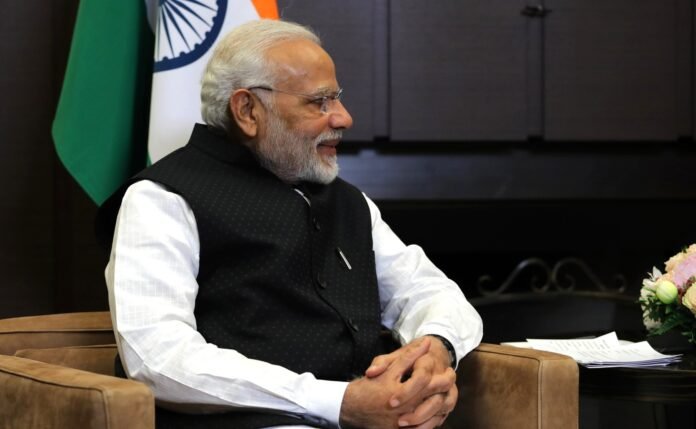As tensions mount over the looming threat of higher tariffs, Indian Prime Minister Narendra Modi and United States Vice-President JD Vance met in New Delhi this week to reaffirm both nations’ commitment to an increasingly strategic and multifaceted partnership. Their discussions signaled progress in bilateral trade negotiations, even as the clock ticks on a 90-day tariff reprieve announced by U.S. President Donald Trump, set to expire on July 9.
A Pivotal Moment for Indo-US Trade Relations
Vice-President Vance’s four-day visit to India with his family coincides with a crucial juncture in Indo-US relations. The backdrop is a potential imposition of 27% tariffs on Indian goods by the United States—a threat only temporarily suspended by President Trump as part of a strategic pause aimed at finalizing improved trade terms.
READ MORE: Ukraine Says Russia Has Ramped Up Attacks Despite ‘Easter Truce’
In a joint public statement, Modi and Vance expressed optimism about ongoing negotiations. “We are committed to mutually beneficial cooperation, including in trade, technology, defence, energy, and people-to-people exchanges,” Prime Minister Modi wrote on social platform X after their meeting, which also included a formal dinner hosted at the Indian leader’s residence.
The Stakes: Tariff Escalation or Economic Opportunity?
The urgency of the talks is underscored by India’s precarious position in the face of possible tariff hikes. Although India is one of several nations negotiating new deals with the U.S., it faces heightened scrutiny from Washington over what American officials describe as an unbalanced trade relationship.
U.S. Trade Representative Jamieson Greer reiterated this concern following Vance’s meeting with Modi. “There is a serious lack of reciprocity in the trade relationship with India,” he said, referencing high Indian tariffs on key U.S. exports, including agricultural goods and technology.
President Trump has repeatedly criticized India for its protectionist policies, often referring to the country as the “tariff king” and accusing it of exploiting American trade generosity. However, India has responded in recent months by reducing tariffs on several goods and signaling willingness to do more, though some areas—particularly agriculture—remain sticking points.
Agriculture: The Thorny Issue in Trade Talks
The agriculture sector represents one of the most contentious issues in the trade negotiations. The United States wants expanded access for its agricultural exports, especially corn and soybeans, but India has been cautious, citing food security, farmer livelihoods, and domestic resistance to genetically modified crops.
The issue is compounded by the political significance of agriculture in India, where farmers represent a large voting bloc and wield significant influence. Modi’s administration has to strike a delicate balance between opening markets to appease U.S. demands and protecting domestic interests.
An earlier proposal by the U.S. to increase corn exports to India received a lukewarm response from Indian policymakers, who cited regulatory concerns and potential backlash from farming communities.
Strengthening Strategic Cooperation
Beyond trade, the Modi-Vance talks delved into key areas of bilateral cooperation, including defense, strategic technologies, and energy security. Both leaders reiterated their commitment to advancing cooperation in the Indo-Pacific, a region increasingly viewed as pivotal in the global strategic balance.
The two sides also emphasized shared democratic values, technological collaboration, and increasing convergence in defense partnerships. India has emerged as a crucial ally in the U.S. Indo-Pacific strategy, especially as Washington seeks to counterbalance China’s growing influence.
Modi’s office confirmed that defense collaboration and emerging technologies, such as artificial intelligence and quantum computing, featured prominently in the discussions. Energy cooperation, particularly in liquefied natural gas (LNG) and renewables, was also explored, with the U.S. expected to expand its energy exports to meet India’s growing demand.
A Personal Touch: The Vance Family in India
Vice-President Vance’s visit also carried strong personal undertones. Accompanied by his wife Usha and their three children, the trip included efforts to reconnect with Usha’s Indian heritage. Her parents originally migrated to the United States from the southern Indian state of Andhra Pradesh.
Photos of the Vance children dressed in traditional Indian attire—kurta-pyjamas for the boys and a lehenga for their daughter Mirabel—made headlines across Indian newspapers and television channels. In a symbolic gesture, Prime Minister Modi gifted the children peacock feathers during the family’s visit to his residence, underscoring the cultural significance of the visit.
Following official meetings in Delhi, the Vance family travelled to Jaipur, where they visited the Amer Fort—a 16th-century palace and UNESCO World Heritage Site. Vance is scheduled to deliver a policy address on U.S.-India relations during his time in Rajasthan’s capital.
On Wednesday, the family will visit the iconic Taj Mahal in Agra before concluding their trip and returning to the United States.
The Road Ahead: Countdown to July 9
As the July 9 deadline for resumption of higher U.S. tariffs draws near, the pressure is on both sides to finalize a comprehensive and mutually agreeable trade pact. While significant strides have been made, particularly in tariff concessions and sectoral access, several complex issues remain on the table.
Despite the challenges, both Modi and Vance struck a positive note, reaffirming their governments’ intent to deepen economic engagement.
Prime Minister Modi also extended an invitation to President Trump to visit India later this year, likely during the Quad Summit. This would mark a further cementing of ties amid rising geopolitical competition and economic realignment.
Conclusion: A Trade Deal Within Reach?
While no formal deal has yet been signed, the tone and substance of the Modi-Vance meeting suggest that a breakthrough is possible. The groundwork laid during this visit could pave the way for a finalized agreement before the tariff pause ends.
For India, securing favorable terms while protecting its domestic industries is paramount. For the U.S., ensuring market access and balancing trade imbalances remains key. As both nations navigate this critical moment, the outcome could shape not only their bilateral ties but also the broader strategic architecture of the Indo-Pacific region in the years ahead.
